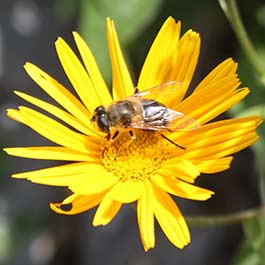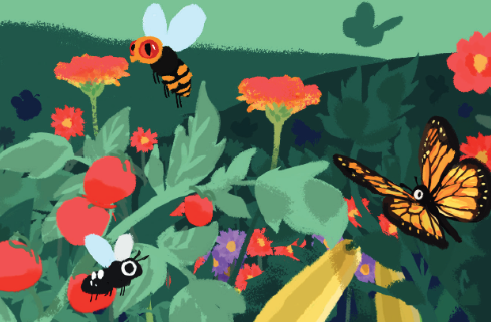BUZZ
Wild pollinators
Pollinators are a diverse group of animals. In addition to insects, pollinators include bats, rodents, possums, lemurs, lizards, birds, and marine invertebrates. Lizards are important pollinators on some remote islands, lemurs pollinate one palm species on Madagascar, honey possums pollinate trees in Australia, and marine invertebrates pollinate at least one species of seaweed in tropical seas.
Globally, the most important pollinators are insects. In our climate, we consider two groups to be the most important: the bees (the Anthophila group) and the hoverflies (family Syrphidae). Other insects also contribute to pollination, especially butterflies, beetles, and other flies (not just hoverflies). The most important pollinators of cocoa, the main ingredient of chocolate, are tiny flies (2-3 mm) from the family Ceratopogonidae.
The best-known pollinator species is the Western honeybee, Apis mellifera, the most abundant and widespread managed pollinator in the world. It is native to Africa, Europe, and parts of Asia, but was introduced widely outside of its range for beekeeping. Honeybees and other managed pollinator species are important for their contribution to agriculture and the economy. Beekeeping also largely contributed to awareness about the importance of pollination and pollinators. However, it is important to emphasize that the honeybee, together with other managed pollinators, makes only a small part of the total diversity of wild pollinators.
There are at least 720 species of wild bees in Croatia, and more than 2,000 in Europe. About 6,000 species of hoverflies are known to science globally. The total number of insect species in the world that participate in pollination is estimated to be 220 thousand. This amazing diversity of wild pollinator species also means ecological diversity: they are of different sizes, body shapes, hairiness, and they are active at different times of the day (diurnal and nocturnal pollinators) or seasons (spring and autumn species). Ecological diversity is necessary for the pollination of equally diverse plant communities. Due to their ecological diversity, the ecosystem services provided by wild pollinators are irreplaceable in both natural and agricultural ecosystems.

Pollinator decline
Even though the importance of pollinators has been known for a long time, they have recently begun to attract more attention. The main reason for this interest are scientific findings concerning pollinator decline in many parts of the world – their diversity and abundance are decreasing. The main drivers of pollinator decline are caused by human activity: intensive agriculture and overuse of pesticides, habitat loss, climate change, various pathogens, and invasive alien species. Due to the role that pollinators play in the ecosystem, their disappearance can have drastic consequences for food safety and the resilience of terrestrial ecosystems. Pollinators also very much influence the quality of our lives – for example, we can thank them for our cup of coffee – their visits to flowers increase coffee quality and yields. Cocoa, plums, almonds, zucchini, cucumbers, watermelon, buckwheat, pomegranate, cherries, and sour cherries – are just some of the pollinator dependent plants that represent not only nutritional value but also an important source of vitamins. The world without the pollinators would certainly look differently than the world that we know.
According to the 2014 Red List of European Bees, which shows the risk of species becoming extinct, 76 species of wild bees are threatened with extinction, 101 species near threatened, while 659 of them have the status of “least concern”. Most wild bees, however, as many as 1,048 species, were assessed as “data deficient”, which means that there was not enough data to estimate their status. The best-known group of bees in Europe, and also the most threatened according to current data, are bumblebees (genus Bombus). There are 68 known species of bumblebees in Europe, of which 23% are threatened, while 45% have a declining population trend. For hoverflies, the Red List is currently in preparation and is expected to be published in 2022.
Wild bees and hoverflies
The taxonomic focus of Cro Buzz Klima is on two insect groups: wild bees (clade Anthophila) and hoverflies (family Syrphidae). These two groups are considered the most important pollinators in the temperate zone of the world. They are, in addition to butterflies, the target taxa in the proposal for a European Union pollinator monitoring program. For both wild bees and hoverflies of Croatia we have very little data and hardly any scientific resources.
Wild bees, clade Anthophila, are the most important pollinators globally. Bees are actually vegetarian wasps, which separated from predatory wasps more than 100 million years ago, when they switched to a plant diet. Today, there are over 20,000 species of bees in the world, over 2,000 in Europe, and an estimated 720 species in Croatia.
Bees are mostly solitary animals – they do not live in organized societies like their most famous representative, honeybees. Most female bees build their own nests, lay eggs and collect food for their offspring. The majority of species nest in the soil, while some bees also like old wood, hollow stems, or abandoned land snail shells. Bee diversity is highest in dry and warm climates, such as the Mediterranean, so we expect the greatest diversity in coastal Croatia. Bumblebees are an exception – genus Bombus evolved in the Himalayan region and developed adaptations to a colder climate. Bumblebees are most diverse in mountainous regions.




Hoverflies, the family Syrphidae, are a diverse fly (order Diptera) family with around 6000 species described in the world, and about 1000 in Europe. Hoverflies are common and abundant insects of terrestrial habitats, but we rarely notice them, because most species mimic the appearance of wasps, bees, or bumblebees. In addition, hoverflies also behave like bees: they fly from flower to flower where they feed on nectar and pollen. Due to their abundance, and due to the dependence of adult individuals on nectar and pollen, hoverfly flies are, after bees, the second most important group of pollinators in the temperate zone.
The larvae of hoverflies, unlike bees, do not depend on flower resources but develop in rotten wood, soil, water or as active predators. Some hoverfly larvae feed exclusively on aphids, contributing to aphid control in agriculture. For hoverfly protection, in addition to floral resources, we need to consider the heterogeneity of habitats and the availability of places and resources for larval development.
The name of this group – hoverflies – tells us about their exceptional flight ability. As all flies, they have only one pair of wings, but they use them very skillfully, and can often be seen “hovering”. Their flying ability is also important for pollination. Because they have a greater flying range than most bee species, and some species migrate over long distances, hoverflies can transfer pollen between distant plant populations.




Pollinator politics
Because pollinator decline can have serious consequences for food safety and the stability of terrestrial ecosystems, pollinators have started to feature in policies, strategic documents, and reports at international, European, and national levels. These documents report and analyze, call for action, warn of shortcomings in current legislation, and define obligations to protect pollinators. Here are just a few:
- 2016 IPBES report: Pollinators, pollination and food production. Thematic assessment of the Intergovernmental Scientific-Policy Platform on Biodiversity and Ecosystem Services (IPBES). Scientists and experts report on the current state of pollinators on more than 500 pages, identify the main drivers of change, assess ecosystem services provided by pollinators, and propose possible solutions to address risks and threats.
- 2018 EU Pollinator Initiative – European Commission initiative proposing 10 measures within 3 priority areas: increasing knowledge about pollinators, eliminating the causes of vulnerability, and raising awareness and collaboration.
- 2020 The European Court of Auditors’ thematic report 15/2020: Protection of wild pollinators in the EU: The Commission’s initiatives have not borne fruit – Report that identifies shortcomings in current legislation and makes recommendations for more effective protection and recovery of pollinator
- 2020 EU Biodiversity Strategy to 2030 – one of the most important strategic documents for the environmental sector at the EU level, in which pollinator decline is directly addressed under the key commitments for nature restoration (“reverse the pollinators decline”).
- 2020 Climate Change Adaptation Strategy in the Republic of Croatia for the period until 2040 with a view to 2070 – National strategic document in which pollinators are recognized as particularly vulnerable to climate change, and which proposes multidisciplinary pollinator research as one of the adaptation measures of very high importance.
- 2021 Proposal of the European Union Pollinator Monitoring Program – An international team of experts mandated by the European Commission proposes a detailed methodology for monitoring pollinator populations in Europe. This document has informed and inspired many of the Cro Buzz Klima activities.
- 2021 European Climate Law – EU regulation with a legally binding target of net zero greenhouse gas emissions by 2050, that bounds EU Institutions and the Member States to reduce greenhouse emissions and strengthen carbon sinks, including through nature-based solutions andecosystem-based adaptation.
Resources and Press
News
Find out the news about the Cro Buzz Climate project
SPRING final meeting
Last week we were in Bologna, attending the final meeting of the SPRING project partners. The main goals of this...
Policy buzz
This week European Commission announced the new EU Pollinator Initiative, the updated and strengthened version of...
Hoverfly taxonomy course
We spent the last week in Novi Sad, attending the advanced hoverfly identification course, organized within the...



